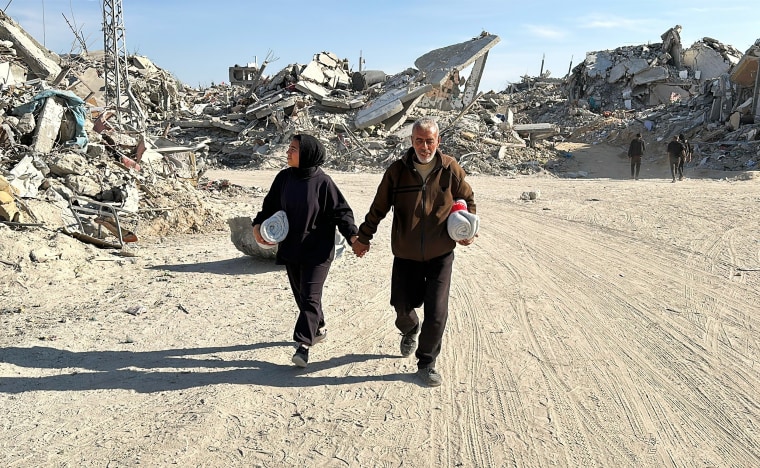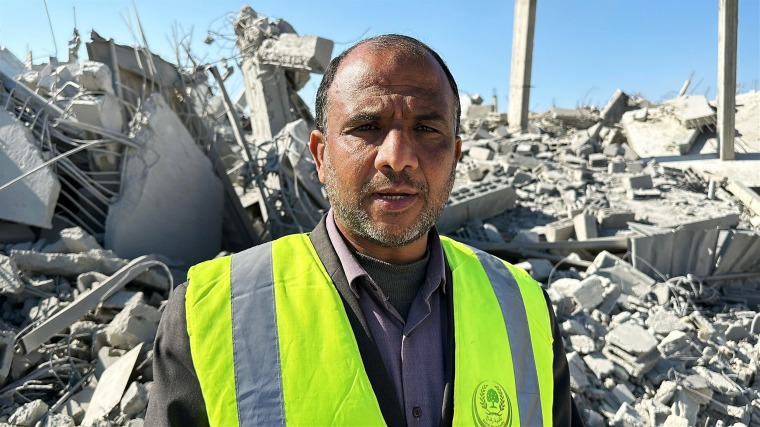When Walid Abu Libdeh returned to Rafah with his young daughter, the 61-year-old engineer felt as though he were “in a horrible film” as he moved through the rubble-strewn streets, trying to figure out where his home once stood.
“Where are the houses? Where are the trees? Where are the animals? Where are the people we love?” he told NBC News’ ground crew in the southern Gaza city on Wednesday.
What has happened in Rafah feels like “Hiroshima or Nagasaki,” Libdeh added.
Six months ago, Rafah, on the Gaza-Egypt border, was home to well more than a million Palestinians who had been forcibly displaced from the war in the Gaza Strip, according to United Nations estimates. Now, the picture looks drastically different as Palestinians wade through rubble and debris to see what is left standing in their city.

Months of Israeli aerial bombardment have hammered the city and caused “almost total devastation,” Khaled Mohamed Al-Sheikh Eid, an engineer heading the debris removal and roads opening committee for the municipality of Rafah, told NBC News’ ground crew Wednesday.
“We were very surprised by the extent of the destruction and debris on the roads,” Al-Sheikh Eid added. “It has become evident to us that the level of destruction is enormous.”
Since the Israel-Hamas ceasefire went into effect late last week, almost 3,000 aid trucks have so far entered Gaza to help the city begin to rebuild, U.N. spokesperson Adnan Abu Hasna told NBC News.
In Rafah's Al-Shawka area, NBC News video footage captured hundreds of trucks carrying food and fuel entering through the Kerem Shalom crossing Wednesday.
Armed guards and masked men — some of them Hamas militants and others ordinary Palestinian merchants to protect trucks — supervised their safe passage to ensure their distribution.

Local health officials say more than 47,000 people have been killed in Israeli bombing during the conflict, which began Oct. 7, 2023, when the Palestinian militant group Hamas carried out a terrorist attack on Israel in which Israeli officials say 1,200 people were killed and 251 people taken hostage.
With a ceasefire deal now in place and Israeli hostages and Palestinians held in Israeli prisons starting to return to their homes, Israeli officials have agreed to allow at least 600 truckloads of aid into Gaza daily during the deal's initial six weeks.
That aid is much needed: The U.N. has estimated that around 60% of Gaza’s infrastructure, including schools and hospitals, has been destroyed. That has left around 90% of Gaza’s population — almost 1.9 million people — displaced from their homes.
In Rafah, Al-Sheikh Eid said that preliminary estimates indicated around 70% of the buildings had been partially or completely destroyed, adding that all communication networks, water systems, sewage systems and electricity infrastructure had also been demolished.
Given the urgent need to rebuild, a plan has been devised dividing streets into three sections: “main roads, secondary roads and smaller streets within neighborhoods,” Al-Sheikh Eid said.
With the daunting task of removing the piles of rubble and rebuilding smaller roads requiring heavy machinery, the focus will remain on opening main roads by pushing debris to the roadside to allow vehicles to pass through, he added.
Standing on a dusty road with his daughter, Libdeh pointed to the remains of demolished buildings. “This street, it was a very beautiful street,” he said. Now, “it’s just a mountain of concrete blocks.”